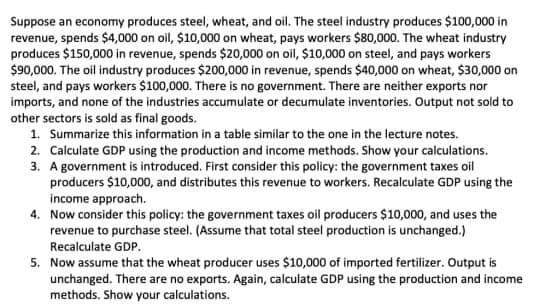Suppose an economy produces steel, wheat, and oil. The steel industry produces $100,000 in revenue, spends $4,000 on oil, $10,000 on wheat, pays workers $80,000. The wheat industry produces $150,000 in revenue, spends $20,000 on oil, $10,000 on steel, and pays workers $90,000. The oil industry produces $200,000 in revenue, spends $40,000 on wheat, $30,000 on steel, and pays workers $100,000. There is no government. There are neither exports nor imports, and none of the industries accumulate or decumulate inventories. Output not sold to other sectors is sold as final goods. 1. Summarize this information in a table similar to the one in the lecture notes. 2. Calculate GDP using the production and income methods. Show your calculations. 3. A government is introduced. First consider this policy: the government taxes oil producers $10,000, and distributes this revenue to workers. Recalculate GDP using the income approach. 4. Now consider this policy: the government taxes oil producers $10,000, and uses the revenue to purchase steel. (Assume that total steel production is unchanged.) Recalculate GDP. 5. Now assume that the wheat producer uses $10.000 of imported fertilizer Outnut is
Suppose an economy produces steel, wheat, and oil. The steel industry produces $100,000 in revenue, spends $4,000 on oil, $10,000 on wheat, pays workers $80,000. The wheat industry produces $150,000 in revenue, spends $20,000 on oil, $10,000 on steel, and pays workers $90,000. The oil industry produces $200,000 in revenue, spends $40,000 on wheat, $30,000 on steel, and pays workers $100,000. There is no government. There are neither exports nor imports, and none of the industries accumulate or decumulate inventories. Output not sold to other sectors is sold as final goods. 1. Summarize this information in a table similar to the one in the lecture notes. 2. Calculate GDP using the production and income methods. Show your calculations. 3. A government is introduced. First consider this policy: the government taxes oil producers $10,000, and distributes this revenue to workers. Recalculate GDP using the income approach. 4. Now consider this policy: the government taxes oil producers $10,000, and uses the revenue to purchase steel. (Assume that total steel production is unchanged.) Recalculate GDP. 5. Now assume that the wheat producer uses $10.000 of imported fertilizer Outnut is
Brief Principles of Macroeconomics (MindTap Course List)
8th Edition
ISBN:9781337091985
Author:N. Gregory Mankiw
Publisher:N. Gregory Mankiw
Chapter7: Production And Growth
Section: Chapter Questions
Problem 5CQQ
Related questions
Question

Transcribed Image Text:Suppose an economy produces steel, wheat, and oil. The steel industry produces $100,000 in
revenue, spends $4,000 on oil, $10,000 on wheat, pays workers $80,000. The wheat industry
produces $150,000 in revenue, spends $20,000 on oil, $10,000 on steel, and pays workers
$90,000. The oil industry produces $200,000 in revenue, spends $40,000 on wheat, $30,000 on
steel, and pays workers $100,000. There is no government. There are neither exports nor
imports, and none of the industries accumulate or decumulate inventories. Output not sold to
other sectors is sold as final goods.
1. Summarize this information in a table similar to the one in the lecture notes.
2. Calculate GDP using the production and income methods. Show your calculations.
3. A government is introduced. First consider this policy: the government taxes oil
producers $10,000, and distributes this revenue to workers. Recalculate GDP using the
income approach.
4. Now consider this policy: the government taxes oil producers $10,000, and uses the
revenue to purchase steel. (Assume that total steel production is unchanged.)
Recalculate GDP.
5. Now assume that the wheat producer uses $10,000 of imported fertilizer. Output is
unchanged. There are no exports. Again, calculate GDP using the production and income
methods. Show your calculations.
Expert Solution
This question has been solved!
Explore an expertly crafted, step-by-step solution for a thorough understanding of key concepts.
This is a popular solution!
Trending now
This is a popular solution!
Step by step
Solved in 4 steps

Recommended textbooks for you

Brief Principles of Macroeconomics (MindTap Cours…
Economics
ISBN:
9781337091985
Author:
N. Gregory Mankiw
Publisher:
Cengage Learning

Essentials of Economics (MindTap Course List)
Economics
ISBN:
9781337091992
Author:
N. Gregory Mankiw
Publisher:
Cengage Learning

Brief Principles of Macroeconomics (MindTap Cours…
Economics
ISBN:
9781337091985
Author:
N. Gregory Mankiw
Publisher:
Cengage Learning

Essentials of Economics (MindTap Course List)
Economics
ISBN:
9781337091992
Author:
N. Gregory Mankiw
Publisher:
Cengage Learning